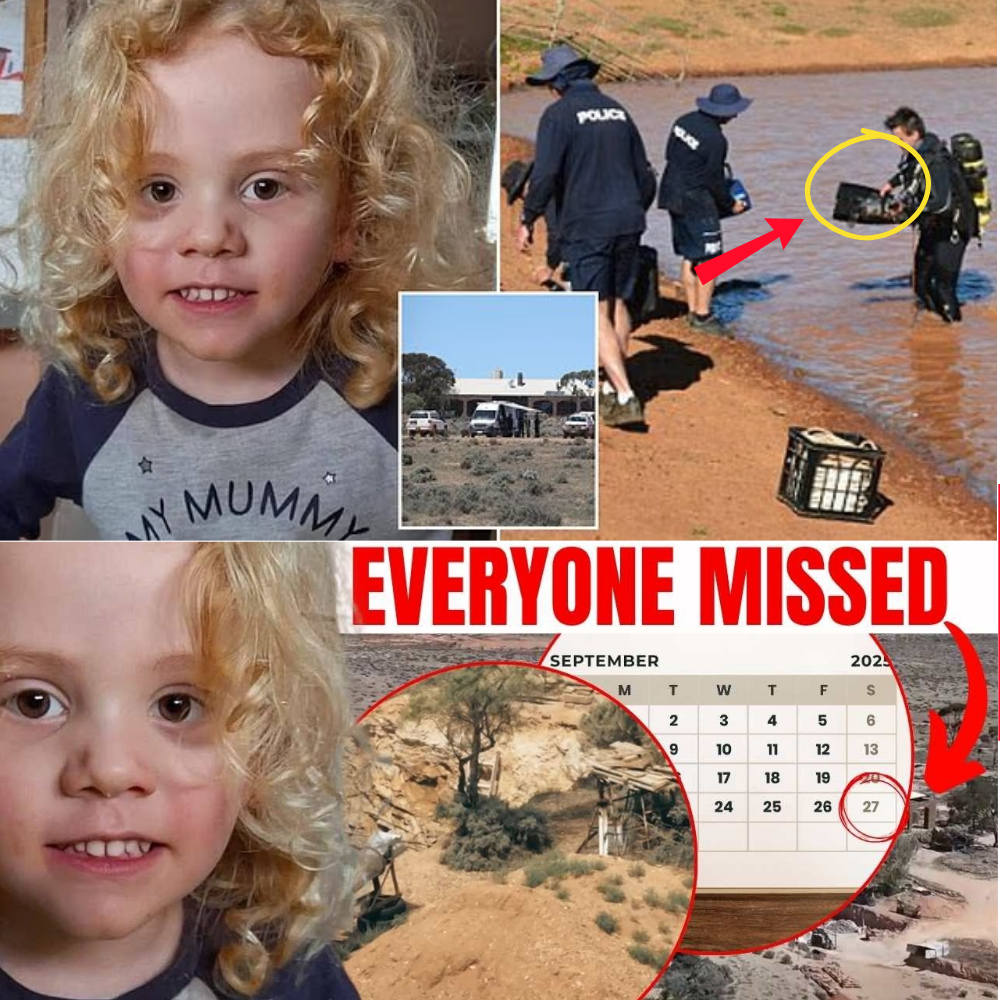
In the scorched heart of South Australia’s vast outback, where the horizon stretches endlessly under a merciless sun, a family’s nightmare stretches into its sixth week. Four-year-old Gus Lamont, the curly-haired cherub with a penchant for adventure, has been missing since September 27, 2025. Last seen frolicking on a dirt mound near his family’s remote sheep station, the boy’s disappearance has gripped the nation, spawning theories, tears, and tireless searches across unforgiving terrain. Now, more than a month later, police are mounting a third desperate expedition back to Oak Park Station near Yunta – this time, with a chilling new tactic: draining a massive dam that could hold the key to the mystery.
The announcement hit like a thunderclap on October 29, as South Australia Police revealed plans to return to the 60,000-hectare property, located about 40 kilometers south of the dusty town of Yunta and 300 kilometers north of Adelaide. The focus? A large dam, roughly 600 meters from the homestead, measuring four-and-a-half meters deep and tangled with underwater vegetation. Divers scoured its murky depths shortly after Gus vanished, but came up empty. Now, in a bid to leave no stone – or submerged reed – unturned, authorities will pump the water dry, exposing every inch for a “comprehensive visual search.” “The renewed search of the dam is being undertaken to rule out the possibility Gus may have drowned,” police stated bluntly, their words a gut-punch to a family clinging to fading hope.
Gus’s story is the stuff of parental dread, unfolding on the evening of that fateful Saturday. The shy but spirited toddler, with his long blond curls and infectious grin, was under the watchful eye of his grandmother, Shannon Murray, at the homestead. His mother, Jessica Lamont, and another grandparent were tending to the station’s flock about 10 kilometers away, leaving Shannon to juggle Gus and his one-year-old brother, Ronnie. At around 5 p.m., as the sun dipped toward the horizon, Shannon glanced out and saw Gus happily playing on a nearby mound of dirt – his grey sun hat perched jauntily, a blue long-sleeve T-shirt emblazoned with a yellow Minion hugging his small frame, light-grey pants and boots completing the picture of innocent outback exploration.
Thirty minutes later, that joyful image shattered. Gus was gone. The family launched a frantic three-hour hunt across the sprawling property before alerting police around 8 p.m. What followed was a monumental mobilization: helicopters thumping overhead, SES volunteers on foot, ADF personnel combing the scrub, and even Indigenous trackers lending their ancient knowledge to the modern machinery. The initial search blanketed over 470 square kilometers, later narrowing to 95 square kilometers in focused sweeps. Aerial imagery, ground teams, even cadaver dogs – nothing yielded a trace. No tiny boot prints (a false lead near the dam turned out to be another’s), no scraps of clothing snagged on spinifex, no signs of the adventurous little boy who’d wandered just a bit too far.
By mid-October, the operation scaled back, hearts heavy with the void. A second push in early October, expanded on advice from survival specialists, incorporated advanced thermal imaging and wider radii, but again, silence from the red earth. Task Force Horizon, the dedicated investigative unit, was formed to chase every lead, from meteorological data charting wind patterns that might have carried a child’s cry, to physiological models estimating how far a four-year-old could trek in the blistering heat. Experts like Flinders University’s Nina Siversten weighed in, suggesting Gus might have strayed beyond initial zones – perhaps covering kilometers in a disoriented dash before exhaustion set in. Temperatures that day hovered around 25°C, not lethal, but the outback’s deceptive allure has claimed many a wanderer.
The Lamonts, a resilient clan forged in the isolation of sheep farming, have borne this with a stoicism that police describe as both inspiring and heartbreaking. “You can imagine just how they are feeling… without having answers as to exactly where Gus is and what’s happened to him. This would be traumatic for any family,” Commissioner Grant Stevens said earlier this month. Through spokespeople, the family has shared glimpses of their devastation: “We’re stoic but broken,” one relative confided, while Jessica, Gus’s mother, has spoken of her boy’s gentle nature – a child who loved chasing butterflies and “helping” with chores, his laughter echoing across the paddocks. No evidence points to foul play, police emphasize, and the family remains fully cooperative, their days now a blur of interviews, false hopes, and endless what-ifs.
Public reaction has been a torrent of raw emotion. Social media pulses with #BringGusHome, where Aussies from Sydney high-rises to Perth beaches share stories of lost loved ones, light candles in virtual vigils, and donate to support the station’s operations – because even in grief, the sheep must be tended. Conspiracy whispers ripple through forums: Was the dam overlooked too soon? Could dingoes, those cunning outback phantoms, have played a role? One Indigenous tracker, who joined the effort last week, offered quiet optimism: “The land holds secrets, but it also gives them up. We’ll find him.” Skeptics online question the dam drain – “Wouldn’t footprints lead there?” one pondered – while others urge expansion: “Search 10 klicks out; kids move fast when scared.” A Now To Love commenter captured the collective ache: “Let’s hope this is a good outcome that will bring closure and bring Gus home.”
As the third search kicks off today, October 30, the air at Oak Park Station crackles with renewed urgency. Crews will methodically pump the dam dry, sifting through sediment and weeds for any whisper of evidence. Ground teams, bolstered by volunteers, will fan out once more, eyes peeled for anomalies in the 36°C heat. Forensic experts stand ready, and psychologists support the family, whose homestead – once alive with toddler giggles – now feels like a ghost town.
This renewed push isn’t just procedure; it’s a lifeline to answers in a case that’s tested the limits of human endurance and technology. Gus Lamont, the Minion-clad explorer who vanished into the ether, embodies the outback’s dual soul: breathtaking beauty laced with brutal peril. Will draining the dam unearth tragedy, or exonerate it as a red herring? Either way, it peels back another layer of this enigma, reminding us that in Australia’s wild interior, mysteries don’t stay buried forever.
For Jessica, Shannon, and the Lamonts, every dawn without Gus is a dagger. As pumps hum and searchers sweat, the nation holds its breath. The outback is vast, but so is hope – and today, it’s roaring back to life. Gus, if you’re out there, come home. Your family’s waiting, and so is the world that fell in love with your smile.


